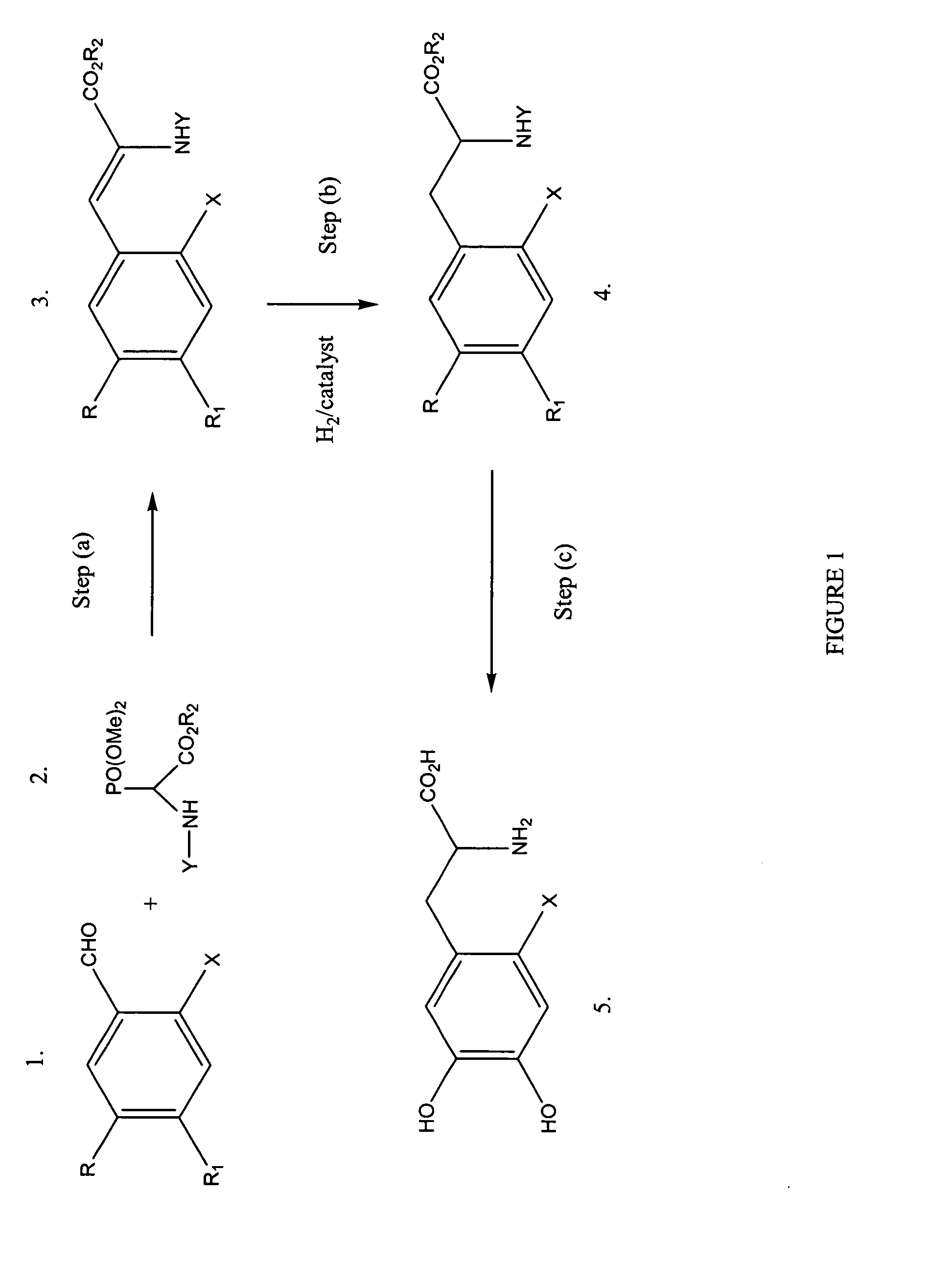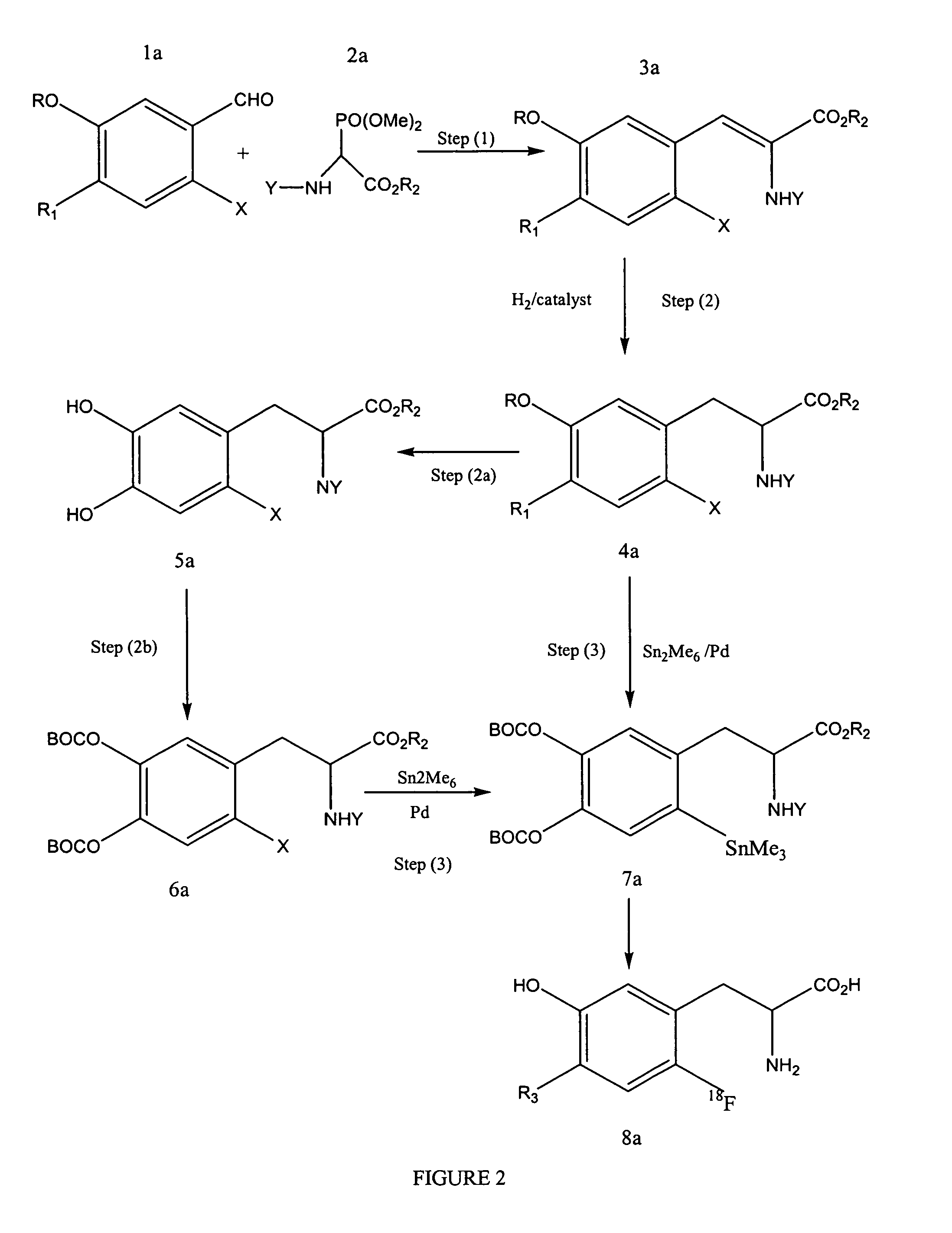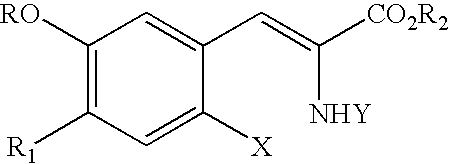Method for making fluorine labeled L-Dopa
a fluorine labeling and method technology, applied in the field of diagnostic imaging technique, can solve problems such as affecting yield and efficiency, and achieve the effect of high optical purity and good yield
- Summary
- Abstract
- Description
- Claims
- Application Information
AI Technical Summary
Benefits of technology
Problems solved by technology
Method used
Image
Examples
example 1
2-t-Butoxycarbonylamino-3-(2-fluoro-4,5-dimethoxy-phenyl)-propionic acid methyl ester
[0064]Step a: synthesis of 2-tert-butoxycarbonylamino-3-(2-fluoro-4,5-dimethoxyphenyl)-acrylic acid ethyl ester. To a stirred solution of 2-fluoro-4,5-dimethoxy benzaldehyde (1.0 g, 5.4 mmol) and 1,1,3,3-tetramethylguanadine (0.9 g, 8.1 mmol) in chloroform (10 mL) is added tert-butoxycarbonylamino-(dimethoxy-phosphoryl)-acetic acid ethyl ester (1.7 g 5.4 mmol) dropwise at room temperature under a N2 atmosphere. The resulting solution is stirred overnight. The solution is concentrated in vacuo and the resulting product is redissolved in chloroform (20 mL) and ethyl acetate (20 mL) and washed with water (30 mL). The pH is lowered to 6 by the addition of HCl (10% solution). The phases are separated and the organic phase is washed with water (30 mL). The combined aqueous phases are concentrated in vacuo to dryness to afford 2.1 g (100%) of a white solid. 1H NMR is consistent with theory.
[0065]In step b,...
example 2
Synthesis of 18F-DOPA Precursor
[0067]Step a: synthesis of iodo olefin intermediate. To a stirred solution of dimethoxyiodo benzaldehyde (1.6 g, 5.4 mmol) and 1,1,3,3-tetramethylguanadine (0.9 g, 8.1 mmol) in chloroform (10 mL) is added tert-butoxycarbonylamino-(dimethoxy-phosphoryl)-acetic acid ethyl ester (1.7 g 5.4 mmol) dropwise at room temperature under a N2 atmosphere. The resulting solution is stirred overnight. The solution is concentrated in vacuo and the resulting product is redissolved in chloroform (20 mL) and ethyl acetate (20 mL) and washed with water (30 mL). The pH is lowered to 6 by the addition of HCl (10% solution). The phases are separated and the organic phase is washed with water (30 mL). The combined aqueous phases are concentrated in vacuo to dryness to afford a white solid.
[0068]In step b, the olefin intermediate is dissolved in ethyl acetate / methanol (1 / 1, 40 mL) with heating. The solution is charged to a glass pressure vessel together with (S,S)-Et-DUPHOS-R...
PUM
| Property | Measurement | Unit |
|---|---|---|
| enantiomeric excess | aaaaa | aaaaa |
| pressure | aaaaa | aaaaa |
| Positron emission tomography | aaaaa | aaaaa |
Abstract
Description
Claims
Application Information
 Login to View More
Login to View More - R&D
- Intellectual Property
- Life Sciences
- Materials
- Tech Scout
- Unparalleled Data Quality
- Higher Quality Content
- 60% Fewer Hallucinations
Browse by: Latest US Patents, China's latest patents, Technical Efficacy Thesaurus, Application Domain, Technology Topic, Popular Technical Reports.
© 2025 PatSnap. All rights reserved.Legal|Privacy policy|Modern Slavery Act Transparency Statement|Sitemap|About US| Contact US: help@patsnap.com



